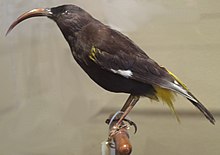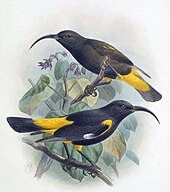Hawaii mamo
| Hawaiʻi mamo | |
|---|---|

| |
| Specimen | |
| Scientific classification | |
| Domain: | Eukaryota |
| Kingdom: | Animalia |
| Phylum: | Chordata |
| Class: | Aves |
| Order: | Passeriformes |
| Family: | Fringillidae |
| Subfamily: | Carduelinae |
| Genus: | Drepanis |
| Species: | †D. pacifica
|
| Binomial name | |
| †Drepanis pacifica (Gmelin, 1788)
| |
The Hawaiʻi mamo (Drepanis pacifica) is an extinct
Description

The bird's natural habitat was limited to the Big Island (Hawaii Island).[3][4] This bird averaged 9 inches (22.86 cm) in length. It was mostly black with bright yellow feathers on its rump, undertail coverts, shoulders, and legs. There was a white patch on the primaries. It had small, black eyes and was the centerpiece of portraits. It had a slightly decurved blackish bill, some three inches long. Juveniles may have been brown.[5]
This shy species lived in the
Its call was a long, plaintive whistle.[18][c]
In Hawaiian culture
The mamo was one of the most honored birds in pre-European Hawaiian society. Its yellow feathers were used to create capes and hats (featherwork) for royalty.[19] Feather collecting contributed to the bird's decline. The famous yellow cloak of Kamehameha I is estimated to have taken the reigns of eight monarchs and the golden feathers of 80,000 birds to complete.[19]
The natives caught the bird by noose or by birdlime, and would lure it by imitating its call.[20] The call is said to be "a single rather long and plaintive note"[18] so this may have been a song rather than a call.[4] The Hawaiian recipe for their sticky birdlime consisted of sap from breadfruit (Hawaiian: ʻulu)[21][22][23] and lobelioids (ʻōhā).[21][24]
The native feather-hunter (poe kawili) had developed (at the behest of King Kamehameha
Settler impact and extinction
Due to their bright colors, the birds were also popular with European collectors.
European settlers changed the mamo's habitat to support agriculture and cattle ranching, which damaged the bird's food source. Cattle roamed loose in the forests, destroying the understory ecosystem. Small Indian mongooses were introduced to control rats, but they also preyed on native birds. Even though this was discovered early and was well known to the Hawaiians, the mamo quickly disappeared.
Introduced disease may have killed any birds that survived habitat destruction. There are many specimens of this bird in American and European museums. The bird had not been particularly scarce until the 1880's.[20][28] But the last live specimen was obtained by Henry C. Palmer in 1892 (this birds has been reported as tame unafraid when captured;[20] Palmer's specimen fed on "sugar and water eagerly", and would stay perched on a twig in the tent[20]).[29][32] The last confirmed sighting dates to July 1898 near Kaumana on the Island of Hawaiʻi, as reported by a collector, Henry W. Henshaw,[33] Henshaw in correspondence to Rothschild revealed that when he spotted and he stalked a family of them, he actually shot and wounded one of them, though it escaped.[34][35]
Explanatory notes
- ^ Authorities in the 20th century refer to the plants as "lobelias".[10][12] Thus Degener construed Oha (ʻōhā) as "Hawaiian Lobelia" and Oha Kepau (ʻōhā kēpau) as "Hawaiian Clermontia".[13] However, all the plants named ʻōhā are now classed as Clermontia, and none retain the genus classification Lobelia (cf. Hawaiian lobelioids).
- ^ Pratt comments that the mamo's diet was probably not restricted to the hāhā and it likely opportunistically fed on other plants.[4] Palmer also mentions attempts to find the bird feeding on an "aku" plant.[14] Emerson writes "ke'a, oha, lehua and mamane" were by bird catchers to attract the mamo, as well as fruits.[9] Greenway adds Pritchardia palms.[12]
- ^ As additional testament of frugivorous habit, bird-catchers used the fruit of the banana or ʻie.ʻie (Freycinetia arborea) to attract the bird.[9]
References
- Citations
- . Retrieved 13 November 2021.
- ^ "Drepanis pacifica. NatureServe Explorer 2.0". explorer.natureserve.org. Retrieved 1 May 2023.
- ^ ISBN 9780715622384.
- ^ ISBN 9780198546535.
- ^ http://julianhume.co.uk/wp-content/uploads/2010/07/Olson-Hume-Drepanis-plumages.pdf [bare URL PDF]
- ^ Rothschild (1900), pp. 160–161.
- ^ Palmer's diary, 13 April 1892.[6]
- ^ Gon (2008) s.v. Hāhā: "Cyanea and Clermontia spp. Members of the Lobeliaceae (=Lobelioideae) are usually known as hāhā or ‘ōhā or ‘ōhāwai".
- ^ a b c Emerson (1894), p. 109.
- ^ a b Degener (1930), p. 288.
- ^ Cf. Palmer also wrote that a forest with "beautiful ohia-trees" might be a likely place to find the mamo (Drepanis pacifica), though the spelling does not match. (Resume of diary, January 1892, Rothschild (1900), p. (Di.) 6 and the "tree on which the Mamo chiefly feeds" apparently refers to this "Ohia" (Rothschild (1900), p. (Di.) 8).
- ^ a b Greenway, James C. (1931). Extinct and Vanishing Birds of the World. New York: American Committee for International Wild Life Protection. p. 418.
- ^ Degener (1930), p. iv.
- ^ Rothschild (1900), p. (Di.) 8.
- ^ . Honolulu: Thomas G. Thrum. p. 418.
- ^ Henshaw reported seeing a pair (before extinction) chasing insects,[15] also quoted by Pratt[4]
- ^ a b Rothschild (1900), p. 162.
- ^ a b The call was demonstrated to Perkins (1903), p. 399).[20][4]
- ^ ISBN 0-684-80083-7.
- ^ ISBN 9781462909544.
- ^ a b Emerson (1894), p. 106.
- ^ a b c Degener, Otto (1930). Illustrated Guide to the More Common Or Noteworthy Ferns and Flowering Plants of Hawaii National Park: With Descriptions of Ancient Hawaiian Customs and an Introduction to the Geologic History of the Islands. Honolulu Star-Bulletin. pp. 129–130.
- ^ a b Little, Elbert L., Jr.; Skolmen, Roger G. (1949). Common Forest Trees of Hawaii (Native and Introduced). Agriculture Handbook 679. U.S. Department of Agriculture. p. 100.
- ^ Palmer's noting that hāhā berries became birdlime, as already noted.[17] Otto Degener says " fruit of plants belonging to the groups called lobelia" (p. 129), where he cross-references to his explanation of "lobelia" known by the Hawaiian names oha (ʻōhā)(p. 288) as aforementioned.
- Hiroa, Te Rangi (1944). "The Local Evolution of Hawaiian Feather Capes and Cloaks". The Journal of the Polynesian Society. 53 (1): 10. Archived from the originalon 2008-10-14.
Apart from the few 'o'o that were killed for specific purposes, the birds caught with bird lime were plucked of their yellow feathers without harm and set free to maintain a future supply. As the duller black feathers of the mamo were not used, it is probable that they were never killed wittingly.
- ^ Little & Skolmen,[23] citing Degener.[22]
- ISBN 9781785702181.
- ^ Though Force&Force (1968) writes that it became extinct by the 1880's.[3]
- ^ Pratt: "by a native collector, working for Henry Palmer" in 1892".[4] citing Munro (1960).
- ^ Rothschild (1900), p. 161.
- ^ Rothschild (1900), p. (Di.) 7.
- ^ 16 April 1892, captured by Ahulau, who set snare and birdlime on the hāhā.[30] cf. also resumé of Palmer's diary.[31]
- ^ Pratt,[4] citing Henshaw (1902).[15] Henshaw writes that a year after his own sighting, a native catcher reported hearing the bird's call, but nevertheless did not lead to capture, thus dating the extinction to 1899.
- ^ W. H. Henshaw, correspondence to Rothschild dated 9 October 1899, concerning the mamo sighting in July the year before, printed in Rothschild (1900), pp. 161–162
- ISBN 9780871137975.
- Bibliography
- Emerson, N. B. (1894). "Ancient Bird-Hunters". Hawaiian Almanac and Annual for 1895. Honolulu: Thomas G. Thrum. pp. 101–111.
- Gon, Samuel M. ʻOhukaniʻōhiʻa, III (2008), Revised List of the Hawaiian Names of Plants Native and Introduced, with brief descriptions and notes as to medicinal or other values
- Rothschild, Walter (1893–1900). The Avifauna of Laysan and the Neighbouring Islands : with a complete history to date of the birds of the Hawaiian possessions (PDF). London: R. H. Porter.; also copy @ biodiversitylibrary.org
External links
- Naturalis.nl: 3D view of Drepanis pacifica specimen (RMNH 110.030) — (requires QuickTime browser plugin).


